SierraScape October - November 2005
Back to Table of Contents
text by Henry Robertson
photos by Alan Ranford
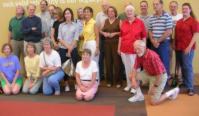 On August 30, some 28 members of the Sierra Club and the
Missouri Coalition for the Environment
toured St. Louis's most advanced building, the
Alberici construction company's
new HQ at I-170 and Page.
On August 30, some 28 members of the Sierra Club and the
Missouri Coalition for the Environment
toured St. Louis's most advanced building, the
Alberici construction company's
new HQ at I-170 and Page.
If you were at the August general meeting, you heard Punit Jain of the St. Louis chapter of the Green Building Council describe the procedure for LEED (Leadership in Energy and Environmental Design) certification of buildings. Alberici achieved the highest level of certification, platinum, with a score of 60 out of a possible 69 points-the highest score yet attained by any building, according to our tour guide, Thomas Taylor of Vertegy, a green building subsidiary of Alberici.
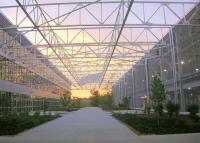 Here are some of the ways Alberici greened its design, using
the categories of the LEED matrix:
Here are some of the ways Alberici greened its design, using
the categories of the LEED matrix:
Sustainable Site. Alberici built on a brownfield site and incorporated parts of the old Vincent Metals fabrication plant into the new structure. Two new retention ponds handle virtually all stormwater without discharging it into the sewers. Native trees and grasses chosen with help from Shaw Nature Reserve provide the landscaping.
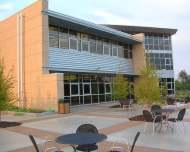 Water Efficiency. Rainwater is captured in an underground
cistern and used to flush toilets with gray water instead of
potable water. Low-flow bathroom fixtures help keep water consumption
78% below that of a traditional building.
Water Efficiency. Rainwater is captured in an underground
cistern and used to flush toilets with gray water instead of
potable water. Low-flow bathroom fixtures help keep water consumption
78% below that of a traditional building.
Energy and atmosphere. Energy efficiency is 60% better than average partly because of passive solar design (optimum placement of windows to take advantage of daylight) and high-performance window glazing. High-efficiency fluorescent lights allow lighting with a lower power density (0.64 watt per square foot compared to the usual two watts). Hot water is preheated with solar panels. A used, 65-kilowatt wind turbine provides 17% of electricity. The company considered geothermal heating and solar photovoltaic electricity but found them too costly. The building has an Energy Star-compliant, high-emissivity white roof, but no green roofing; that would have added $12-$18 per square foot to the cost.
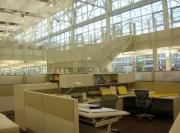 Materials and Resources. The building contains 30% recycled
content, and 57% of its materials came from sources within 500
miles. Alberici diverted 93% of the construction and demolition
waste from the landfill, using some of it on site as a retaining
wall and for structural fill. Many of the indoor materials are
"rapidly renewable," with growth cycles of 10 years
or less, like cork, bamboo and particle board made from wheat.
Low-emitting adhesives, sealants, paints and
carpets enhance indoor air quality. The wood is certified by the
Forest Stewardship Council.
Materials and Resources. The building contains 30% recycled
content, and 57% of its materials came from sources within 500
miles. Alberici diverted 93% of the construction and demolition
waste from the landfill, using some of it on site as a retaining
wall and for structural fill. Many of the indoor materials are
"rapidly renewable," with growth cycles of 10 years
or less, like cork, bamboo and particle board made from wheat.
Low-emitting adhesives, sealants, paints and
carpets enhance indoor air quality. The wood is certified by the
Forest Stewardship Council.
Indoor Environmental Quality. The interior, with work stations instead of enclosed offices, is open and permeated by daylight. Air is distributed from under the floor without a return air system, using 80-90% fresh air. The automated building management system, linked to a weather station on the roof, controls the clerestory windows, but other windows can be opened by hand.
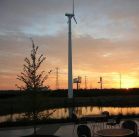 We detained Mr. Taylor for a good two hours, peppering him
with questions. The tour ended on the patio overlooking a pond
as the sun set behind the wind turbine. Except for the Inner
Belt, it was an idyllic sight.
We detained Mr. Taylor for a good two hours, peppering him
with questions. The tour ended on the patio overlooking a pond
as the sun set behind the wind turbine. Except for the Inner
Belt, it was an idyllic sight.